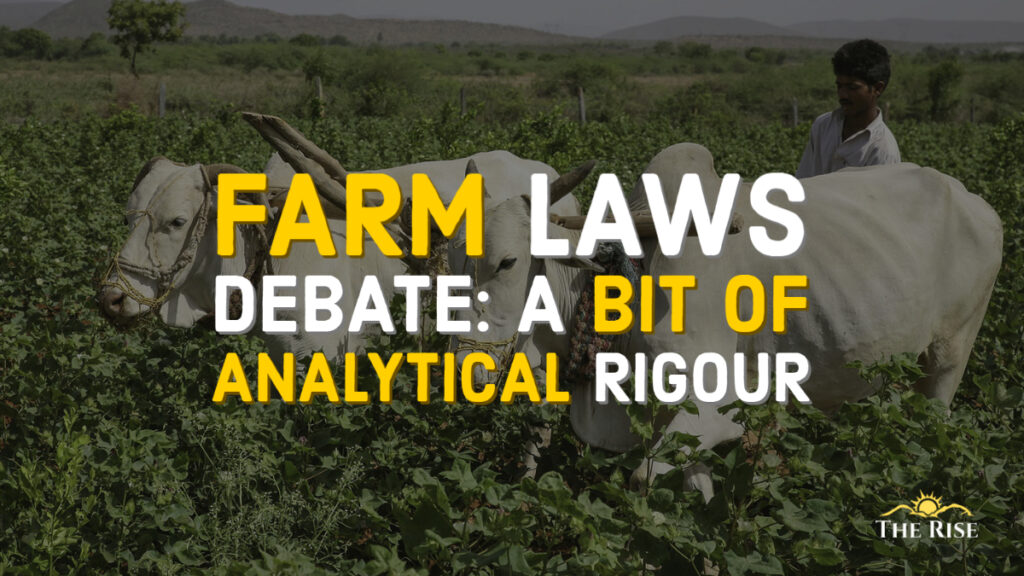There are several lessons to learn from the experiments in the past, like the repeal of APMC in Bihar and the institution of e-NAM, which have elements of the current farm acts. History of little success will be repeated if the mechanics of trading are not understood and actions are not taken to alleviate the constraints.
As the farm bills became the law, one of the afflictions of India’s policy discourse and debate kicked in immediately. Proponents called it a watershed moment – the historic 1991 moment for agriculture – the liberation of farmers, while opponents’ epithets comprised death warrant for farmers, death knell on food security, and other dice with death quotes. There seems to be no middle ground in assessing the implications for the farm laws. The missing middle is because in these debates what is traditionally scarce is the research with analytical rigour in line with the best practices in the world.
The Farmers’ Produce Trade and Commerce (Promotion and Facilitation) Act, 2020 (FPTC) aims to provide farmers with greater capacity to trade across spaces (nationally & internationally) and over time. There is no gainsaying that expanding the choice-sets for farmers in marketing and providing them with disintermediation is needed. Farmers should be enabled to trade in any market that offers the best returns. However, the pertinent question is what enables trading in the first place?
The relevant question here is this: What does FPTC have to offer to farmer’s productivity to enable them to export?
There are important messages from trade economics that can help understand this question.
The first one is based on the idea of firm heterogeneity. The big revolution in trade literature happened in 2003 when trade economist Marc Melitz looked at firms as the relevant trading entities instead of countries or regions. Trade, like migration, involves costs, particularly fixed costs. This implies that only firms that have a certain level of productivity are able to export. The same will apply for farmers as the span of the market expands. The relevant question here is this: What does FPTC have to offer to farmer’s productivity to enable them to export?
Also Read: Farm Acts 2020: Farmer Unions and the Logic of Survival
Only import openness would create conditions for export competitiveness.
If the acts were to truly make farmers export-ready nationally or internationally, India would need much freer imports of inputs, agricultural equipment, and machinery. In one of the studies, the authors have shown that with import liberalization, Bangladesh has become one of the most mechanized agriculture in South Asia. Cheaper Chinese imports of small machines helped the country in raising its agricultural productivity. India continues to levy high tariffs on input imports, including machinery, making it expensive for farmers. This, in turn, impacts the farm productivity. Only import openness would create conditions for export competitiveness.
The 1991 reforms in the industry had the biggest role of import liberalization; import licensing was done away with in intermediate inputs and capital goods. Fast forward to 2020, nothing of that sort has been proposed in the recently enacted farm laws. The déjà vu analysts of 1991 moment for agriculture are missing this point – a real important one!
Even in domestic deregulation, there are productivity restraining conditions. In fertilizer, for instance, urea remains controlled while phosphate and potash have been decontrolled. Notwithstanding the government’s claims on soil health cards, the nutrient ratios remain subpar. Similar productivity muzzling effects abound due to various distortionary subsidies on water, power, and other inputs, like credit.
India continues to levy high tariffs on input imports, including machinery, making it expensive for farmers. This, in turn, impacts the farm productivity.
History is witness to the fact that all successes in the trade have reached commanding heights based on what trade economists call the ‘expansion in trade (nationally & internationally) based on new trade’ i.e., new markets, new products, and varieties at different prices (exemplified by, the rise of China, Chile, or Mexico post-NAFTA). Achieving this would require developing systems for dishing out on attributes like safety, quality, health, and innovations in delivery systems.
Also Read: Agri Bills: Why are Farmers Protesting even after PM’s Assurance?
Think of a consumer sourcing mango from far off places without a system of guarantees or certification. The distribution of value comes only after the creation of value. To enable farmers to trade, the farm laws would need far more serious thinking in the world of non-price attributes, possibly a credible good agriculture practices (GAP) facilitation. Without those in place, trade cannot happen effectively between parties at arm’s length for products, like food, which carry a credence attribute. The outcomes would be plagued by the same problems that have featured in cases such as the much-touted e-NAM.
The crux of the argument should be this: How to make farmers trade- ready and capacitated to benefit from the trade?
Finally, a farmer needs to cover the risks involved in trading. The policy signals funnelling certainty or predictability play a critical role in this. If farmers have to play the market, they need to be signalled that during high prices they would be able to ride the wave. The actions like the export ban in onions (including revoking existing orders), setting up minimum export prices, emergency clauses in the supposedly reformed Essential Commodities Act, are all antithetical to making farmers trade ready.
Also Read: Indian Farmers and Agri Sector Bills: Let us Tour the Issue
The crux of the argument should be how to make farmers trade-ready and capacitated to benefit from trade? There are several lessons to learn from the experiments in the past, like the repeal of APMC in Bihar and the institution of e-NAM, which have elements of the current farm acts. History of little success will be repeated if the mechanics of trading are not understood and actions are not taken to alleviate the constraints.
Disclaimer: The views expressed in this article are of the authors solely. TheRise.co.in neither endorses nor is responsible for them.










Pingback: Perception, reality and optimality of MSP - TheRise.co.in
Pingback: Farm Laws Debate: A Bit of Analytical Rigour and Global Best Practices - IFPRI South Asia Office
Pingback: Where are Topsy Turvy Farmer Protests Heading? - TheRise.co.in
Pingback: Can NEP 2020 show the way to Modi Government on Farm Laws issue?